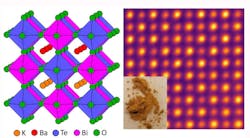Found via data analytics, a nontoxic perovskite shows promise for use in photovoltaics
In the past decade, lead-halide perovskites have emerged as the most promising class of alternatives to silicon for photovoltaic cells; however, these perovskites are unstable. They also contain lead, which is toxic and poses potential health and environmental hazards such as groundwater contamination.
Engineers at Washington University in St. Louis (Missouri) have found what they believe is a more stable, less toxic semiconductor for solar applications: a novel double perovskite oxide, which was discovered through data analytics and quantum-mechanical calculations.1
Rohan Mishra, assistant professor of mechanical engineering and materials science in the McKelvey School of Engineering, led an interdisciplinary, international team that discovered the new semiconductor, made up of potassium, barium, tellurium, bismuth, and oxygen (KBaTeBiO6). The lead-free double perovskite oxide was one of an initial 30,000 potential bismuth-based oxides. Of those 30,000, only about 25 were known compounds.
Found using world-class supercomputing
Using materials informatics and quantum-mechanical calculations on one of the fastest supercomputers in the world, Arashdeep Singh Thind, a doctoral student in Mishra's lab based at Oak Ridge National Laboratory, found KBaTeBiO6 to be the most promising out of the 30,000 potential oxides.
"We found that this looked to be the most stable compound and that it could be synthesized in the lab," says Mishra. "More importantly, whereas most oxides tend to have a large band, we predicted the new compound to have a lower band gap, which is close to the halide perovskites, and to have reasonably good properties." The most promising compounds for solar cell applications have a band gap of about 1.5 eV, notes Mishra.
Shalinee Kavadiya, then a McKelvey Engineering doctoral student and now a postdoctoral research associate at Arizona State University, got to work on perfecting the recipe. "Shalinee spent about six months synthesizing the material," Mishra says. "Once she was able to synthesize it, as we had predicted, it was stable and had a band gap of 1.88 eV, which we also predicted."
Mishra says these are first-generation solar cells that need more fine tuning of the band gap, but that this is a good first step toward nontoxic solar cells.
Next, the team will study the role of any defects in this new semiconductor and look to more advanced synthesis techniques, including using aerosol techniques.
Source: https://source.wustl.edu/2019/07/a-good-first-step-toward-nontoxic-solar-cells/
REFERENCE:
1. Arashdeep Singh Hind et al., Chemistry of Materials (2019); https://doi.org/10.1021/acs.chemmater.9b01025.
About the Author
John Wallace
Senior Technical Editor (1998-2022)
John Wallace was with Laser Focus World for nearly 25 years, retiring in late June 2022. He obtained a bachelor's degree in mechanical engineering and physics at Rutgers University and a master's in optical engineering at the University of Rochester. Before becoming an editor, John worked as an engineer at RCA, Exxon, Eastman Kodak, and GCA Corporation.

